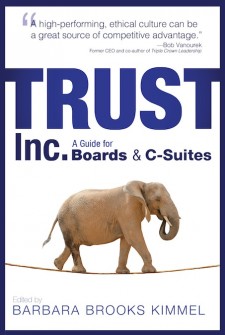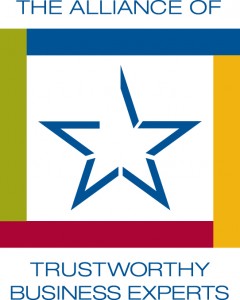Late last year Trust Across America-Trust Around the World published the first in a planned series of award-winning books. TRUST INC., Strategies for Building Your Company’s Most Valuable Asset brings together the wisdom of 32 experts. Six months later we released our second book, Trust Inc. A Guide for Boards & C-Suites. In this book, sixty experts have joined forces to offer 100 strategies.
Throughout the month of August, we will be featuring 31 essays from our second book. Each stands alone as an excellent resource in guiding Boards and C-Suites on driving a trust agenda at the highest level in the organization, and provides tools for those who choose to implement trust-building programs in their organization.
This thirtieth essay brings advice from Charles H. Green, an author, speaker and world expert on trust-based relationships and sales in complex businesses. Founder and CEO of Trusted Advisor Associates, he is co-author of the classic The Trusted Advisor and its practical follow-up, The Trusted Advisor Fieldbook, and author of Trust-based Selling. Charles works with complex organizations to improve trust in sales, internal trust between organizations, and trusted advisor relationships with external clients and customers. He is also a 2014 Top Thought Leader in Trustworthy Business , a member of the Alliance of Trustworthy Business Experts , and serves on Trust Across America’s Steering Committee.
Leading for Trust: Let’s Get Real
Forget incentives, metrics and recognition programs. This is trust you’re talking about – you don’t get there by sprinkling cheese to encourage mice to get through a maze, or by checking boxes for legal compliance.
There is only one thing that will build trust into your organization’s DNA, and there are four steps to get you there. That thing is values based leadership. The steps are:
- Articulate precisely the several trust-related values you will insist on
- Connect frequently the values to specific instances where they should be applied
- Role-model yourself those values wherever possible
- Sanction or fire those who violate the values of the organization.
Why is values-based leadership so critical to establishing organizational trust? Because trust itself is a value. We don’t trust those who just mechanically execute behaviors. We don’t trust those who just see trust as a hook to make money. And we don’t trust those who are motivated by extrinsic rewards.
We trust those who are personally trustworthy, and who have the courage and the judgment to trust us in turn. We trust those for whom trust is a value, not a means to an end. And paradoxically, those people end up achieving more ends anyway.
I hope you have enjoyed this next sneak peak into our second book. If this brief look behind the door has been helpful, follow this link to order both of our books online.
August 1: There’s a Reason Why We Call Them Trustees explains why being an “absentee landlord” doesn’t work.
August 2: Kill the Evening Before Dinner and take a small group of front line employees to dinner instead.
August 3: In Head of Business- Hope for the World we introduce the Winston “V” Model.
August 4: Reputation vs. Trust and why leaders should care more about the latter.
August 5: C-Suite Must Speak With a V.O.I.C.E. of Trust, a new communications model.
August 6: It Ain’t What You Do (It’s the Way You Do It) discusses an organization’s core values and traits.
August 7: Superficial CEOs and Their Boards talks about the fiduciary responsibility of board members.
August 8: Headline: Be the Leaders Others Will Follow we learn about consistency between actions and words.
August 9: Towards a Mindset for Corporate Responsibility requiring a shift in mindset on the part of boards.
August 10: Warning: Don’t Drown in the Slogan Swamp explores the (mis)use of slogans in corporate America.
August 11: Trust in the Boardroom in creating competitive advantage.
August 12: Three Ways to Build Trust and organization that are blind to the dialogue.
August 13: Lead from the Front explains why it’s important to remove the filters between leaders and employees.
August 14: Building Trust For Boards & C-Suites and why published scientific evidence is important.
August 15: (Trust) Communication & the Hiring Process discusses engaging employees in the decision.
August 16: CEO Tip: Trust Your Board as Your Ally emphasizes the importance of trusting partnerships.
August 17: The Culture is the Secret Sauce that must bubble down from the Boardroom to the Mailroom.
August 18: Trust & Strategy Thinking reminds us that it is hard to trust when you cannot relate.
August 19: Be Proactive About Trust & Integrity: just handling problems as they arise is not enough.
August 20: Trust Traps reminds us to ask the tough questions.
August 21: Trust Danger Signs and the need for synergy between the Board and Senior Managers.
August 22: Trust & Public Rewards reminds us to publicly acknowledge and reward staff.
August 23: The Cost of Mistrust and 8 ways to develop it.
August 24: Forward-Thinking Boards Build Trust and will commit to lighthouse leadership and employee engagement.
August 25: When Trust Breaks Down: 5 Steps You Can Take to rebuild it.
August 26: The Key To Trust in the C-Suite is safety, but how do we create it?
August 27: Lead With Integrity & Character reminds us to start with integrity.
August 28: Trust is Built Upon Shadows and you can cast your shadow and light over your team.
August 29: Boards in Crisis- Where Trust is Forged & Broken provides advice for managing crises proactively.
Barbara Brooks Kimmel is the Executive Director of Trust Across America-Trust Around the World whose mission is to help organizations build trust. She is also the editor of the award winning TRUST INC. book series. In 2012 Barbara was named “One of 25 Women Changing the World” by Good Business International.
Should you wish to communicate directly with Barbara, drop her a note at Barbara@trustacrossamerica.com
Copyright © 2014, Next Decade, Inc.





Recent Comments